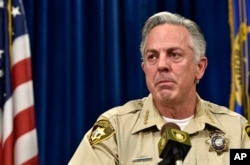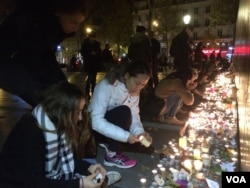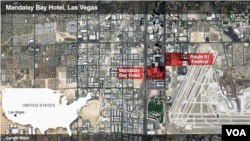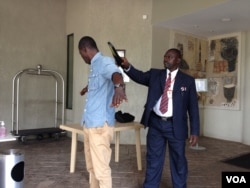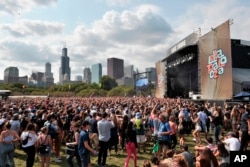As investigators continue their search for what motivated 64-year-old Stephen Paddock to unleash a hailstorm of bullets from a high-rise Las Vegas hotel, killing 58 people and wounding hundreds more, public safety officials are taking a hard look at how they do their jobs.
The central questions are persistent and agonizing: What more could have been done, and what more can be done to further minimize the risks to so-called soft targets, such as concerts, sporting events and other public spaces.
Answers do not come easily.
“I don’t know how it could have been prevented,” Sheriff Joseph Lombardo of the Las Vegas Metropolitan Police Department told reporters earlier this week.
“We didn’t have any prior knowledge to this individual,” Lombardo said. “This is an individual who was described as a lone wolf.”
A city prepared?
Las Vegas, and the state of Nevada, may have been as prepared for a mass shooting as any place in the United States.
Since 2011, the U.S. Department of Homeland Security has held seven active-shooter workshops in Nevada, including five in Las Vegas, drawing hundreds of participants from all levels of government and the private sector.
The Las Vegas police force has been preparing for even longer, adopting an anti-terrorism protocol and training responders for such scenarios, beginning in 2009.
Yet there is a growing consensus among security officials that being aware of the potential risks and having plans to react to any incidents is not enough.
Many venues have begun “looking much farther out in terms of how people approach, arrive and enter facilities,” said Russ Simons, managing partner of Venue Solutions in Brentwood, Tennessee.
“That has been overlaid by specific security devices and procedures like walk-through metal detectors and hand wands, secondary screening perimeters, limits to what types of bags [are allowed in],” Simons said.
Government and private security officials in the U.S. and other Western countries have been grappling with such approaches for almost two years, going back to the November 2015 Islamic State terror attack on a concert venue, a soccer stadium and outdoor restaurants in Paris that killed more than 130 people. And they see the U.S. especially vulnerable.
Security vulnerabilities
The 15-acre Las Vegas Village, targeted in the Oct. 1 shooting, is one of two open-air concert venues MGM Resorts International operates on the Las Vegas Strip. Both are visible from numerous high-rise buildings, giving would-be shooters plenty of potential vantage points.
And of the nearly 140 major sport stadiums in the U.S., many are uncovered and sit next to tall buildings that can serve as a sniper’s perch.
“Those are some of the things that you want to make sure that you factor in to your posture when you set the event up to allow thousands of fans to come in,” said Jeffrey Miller, a former Pennsylvania State Police commissioner and senior vice president at consulting firm MSA Security in New York.
Other key concerns include the susceptibility of venues to suicide bombers, car or vehicle bombs, and attackers who try to turn vehicles into ramming weapons.
These are the types of concerns that have helped prompt some rethinking in Britain, itself no stranger to attacks on high-profile venues, like the May 22, 2017, bombing of an Ariana Grande concert in Manchester, which killed more than 20 people.
“The threat from terrorism is changing and so must our response,” a Home Office spokesperson told VOA. “That is why we are reviewing our counterterrorism strategy and powers and why we have plowed extra resources into counterterrorism.”
In addition to setting aside funding for cutting-edge surveillance and detection technology, Britain has also sought to provide to companies “high quality advice and guidance, to understand the terrorist threat and to enable appropriate measures to be taken to reduce their vulnerability to and prepare for a terrorist attack.”
Focus on prevention
In the U.S., officials are also working closely with the hospitality and entertainment industries “to provide expert counsel and recommendations about protective measures,” the Department of Homeland Security told VOA in an email.
Hotel industry officials also said DHS reached out following the Las Vegas shooting to discuss security assessments.
But DHS officials did not respond to VOA questions about how much of that work focuses on ways venues can physically mitigate the risks in advance.
And DHS online resources focus more heavily on how venues can respond to incidents as opposed to prevention.
Costly answers
Still, some companies and organizations are embracing a more preventative approach on their own.
The National Football League, the largest professional sports league in the United States, has been one of them, installing walk-through metal detectors and other security measures that have been adopted by nearly all stadiums in the country.
The American Hotel and Lodging Association, whose members include some of the best-known U.S. hotel chains, also convened a call of its safety and security committee immediately after the Las Vegas shooting “to begin to assess the impact of this heinous attack.”
“We will continue to work with law enforcement to evaluate the industry’s measures and determine what changes may need to be implemented,” AHLA security adviser Chad Callaghan told VOA in a statement.
But such enhanced security comes at a substantial cost to venue operators — “easily in the hundreds of thousands of dollars per venue,” according to MSA’s Miller — that may make some venues hesitant to adopt them.
Prohibitive to hotels
Richard Hudak, managing partner at Resort Security International and a former head of worldwide security for Sheraton Hotels, says hotels in particular may be unlikely to adopt airport-style security measures, such as walk-through metal detectors, because of their prohibitive cost and inconvenience to guests, although such measures are in place at some American-owned hotels in countries like India and Indonesia.
But open-air venues, like the outdoor concert in Las Vegas, will always present a challenge.
“It’s going to be very difficult,” said John White, president and CEO of the security consultant Protection Management in Canton, Ohio. “They’re outside and not in an area that can be protected.”
Miller, the former Pennsylvania State Police commissioner, said the best hope in protecting such venues, especially those near tall buildings, may ultimately come down to posting “sniper over-watch positions looking outward to monitor any potential high-ground threat.”
“Coordinating with security personnel at each of the nearby buildings that look into the event venue may assist in reducing some of the risk,” he said.





